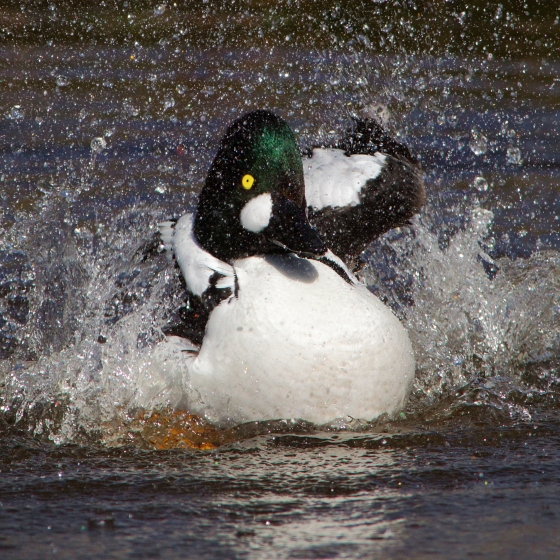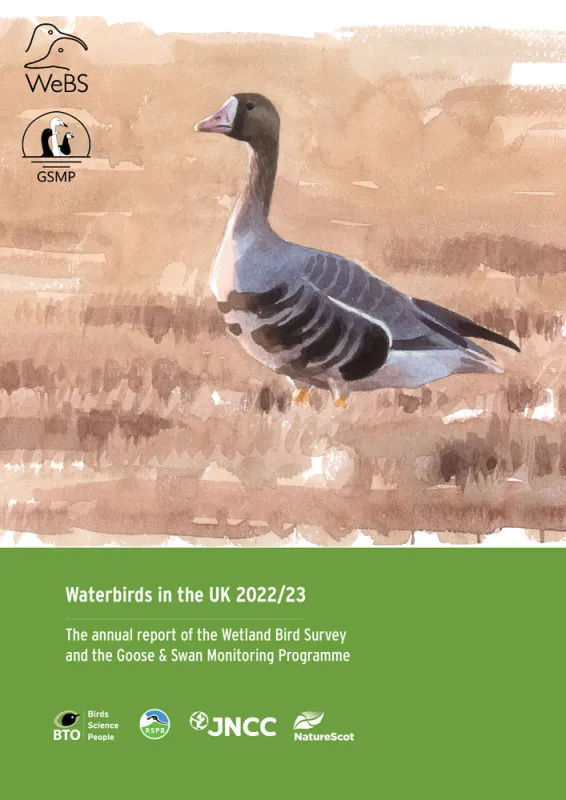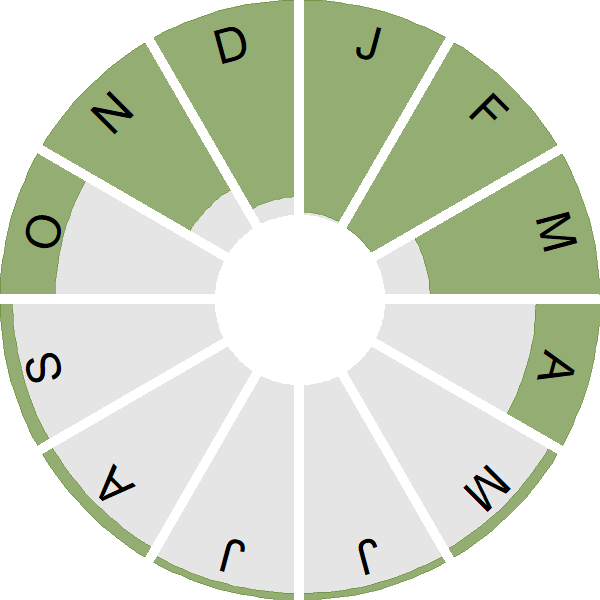Goldeneye

Introduction
This striking duck, with its piercing eye and large rounded head, was first recorded nesting here in the 1970s, since when a relatively small but expanding breeding population has become established.
Goldeneye use tree cavities and nest boxes for breeding, our current population centred on northern Scotland but with isolated records from England. The species a range of freshwater habitats for breeding.
Wintering birds join our breeders from October and are thought to be mostly birds from the Scandinavian breeding population. Individuals can be seen widely in winter, occupying both coastal and inland sites, sometimes in large numbers (e.g. 500 plus).

Key Stats
Identification
Songs and Calls
Call:
Alarm call:
Flight call:
Status and Trends
Conservation Status
Population Change
The Goldeneye has increased substantially from a single-figure breeding population in the 1970s (Eaton et al. 2021). The current population is thought to be around 200 pairs (APEP4), with the majority of the UK population breeding in Scotland, but the more recent trend has not been measured after monitoring of the full Scottish population ceased in 2010 (Eaton et al. 2021)
Distribution
In winter, Goldeneyes are found in coastal areas and a wide variety of freshwater habitats throughout Scotland and northern England, with the exception of some upland areas. Farther south, in England, Wales and Ireland, the distribution is patchier and centred on suitable coastal areas, river valleys and wetland networks. Records of confirmed breeding are concentrated in Strathspey and around the Great Glen in Inverness-shire, along the River Dee in Aberdeenshire, and around Loch Tay in Perthshire. Elsewhere, the only confirmed breeding records are from Northumberland and Avon.
Occupied 10-km squares in UK
2007/08–10/11
or view it on Bird Atlas Mapstore.
2008–11
or view it on Bird Atlas Mapstore.
European Distribution Map
Distribution Change
The number of 10-km squares with probable or confirmed breeding by Goldeneyes increased from 13 to 38 between the 1988–91 and 2008–11 breeding atlases, and includes colonisation of Perthshire and Aberdeenshire.
Change in occupied 10-km squares in the UK
from 1981–84 to 2007–11
or view it on Bird Atlas Mapstore.
from 1968–72 to 2008–11
or view it on Bird Atlas Mapstore.
Seasonality
Goldeneyes are predominantly winter visitors, arriving gradually through September and October, departing through April.
Weekly pattern of occurrence
The graph shows when the species is present in the UK, with taller bars indicating a higher likelihood of encountering the species in appropriate regions and habitats.

Movement
Britain & Ireland movement
Foreign locations of birds ringed or recovered in Britain & Ireland
Dots show the foreign destinations of birds ringed in Britain & Ireland, and the origins of birds ringed overseas that were subsequently recaptured, resighted or found dead in Britain & Ireland. Dot colours indicate the time of year that the species was present at the location.
- Winter (Nov-Feb)
- Spring (Mar-Apr)
- Summer (May-Jul)
- Autumn (Aug-Oct)

European movements
EuroBirdPortal uses birdwatcher's records, such as those logged in BirdTrack to map the flows of birds as they arrive and depart Europe. See maps for this species here.
The Eurasian-African Migration Atlas shows movements of individual birds ringed or recovered in Europe. See maps for this species here.
Biology
Productivity and Nesting
Nesting timing
Egg measurements
Clutch Size
Survival and Longevity
Survival is shown as the proportion of birds surviving from one year to the next and is derived from bird ringing data. It can also be used to estimate how long birds typically live.
View number ringed each year in the Online Ringing Report.
Lifespan
Survival of adults
Biometrics
Wing length and body weights are from live birds (source).
Ring Size
Classification, names and codes
Classification and Codes
- Order: Anseriformes
- Family: Anatidae
- Scientific name: Bucephala clangula
- Authority: Linnaeus, 1758
- BTO 2-letter code: GN
- BTO 5-letter code: GOLDE
- Euring code number: 2180
Alternate species names
- Catalan: morell d'ulls grocs
- Czech: hohol severní
- Danish: Hvinand
- Dutch: Brilduiker
- Estonian: sõtkas
- Finnish: telkkä
- French: Garrot à oeil d’or
- Gaelic: Lach-bhreac
- German: Schellente
- Hungarian: kerceréce
- Icelandic: Hvinönd
- Irish: Órshúileach
- Italian: Quattrocchi
- Latvian: gaigala, nira
- Lithuanian: paprastoji klykuole
- Norwegian: Kvinand
- Polish: gagol
- Portuguese: olho-dourado
- Slovak: hlaholka severská
- Slovenian: zvonec
- Spanish: Porrón osculado
- Swedish: knipa
- Welsh: Hwyaden Lygad Aur
- English folkname(s): Rattlewing
Research
Causes of Change and Solutions
Causes of change
The drivers behind the initial colonisation of Scotland are unclear but the subsequent increases may have been aided by the provision of nest boxes within its core range in Scotland (Dennis & Dow 1984). Predation by Pine Martens has been identified as the most important factor affecting breeding success (Langridge 1996) and there are also concerns about the possible impact of the expanding non-native Mandarin Duck population through competition for nest sites (Cosgrove 2003). There is currently no evidence of any negative impact on the population from these or other factors although the population trend has not been monitored since 2010.
Publications (3)
Waterbirds in the UK 2022/23
Author: Woodward, I.D., Calbrade, N.A., Birtles, G.A., Feather, A., Peck, K., Wotton, S.R., Shaw, J.M., Balmer, D.E. & Frost, T.M.
Published: Winter 2024
It provides a single, comprehensive source of information on the current status and distribution of waterbirds in the UK for those interested in the conservation of the populations of these species and the wetland sites they use. Data from this edition of Waterbirds in the UK provide further evidence that wintering ducks, geese, swans and waders are adapting to climate change by altering their migration.
25.04.24
Reports Waterbirds in the UK

Behavioural responses of non-breeding waterbirds to marine traffic in the near-shore environment
Author: Jarrett, D., Calladine, J., Cook, A.S.C.P., Upton, A., Williams, J.,Williams, S., Wilson, J.M., Wilson, M.W., Woodward, I. & Humphreys, E.M.
Published: 2022
Marine traffic is increasing globally, but there has been little research investigating the impact of this disturbance, particularly for non-breeding populations in near-shore environments. This study observed the behaviour of 11 seabird species in response to winter ferry passage around Orkney, increasing the evidence base available to inform impact assessments, planning and policy in the marine environment.
02.09.22
Papers

The status of our bird populations: the fifth Birds of Conservation Concern in the United Kingdom, Channel Islands and Isle of Man and second IUCN Red List assessment of extinction risk for Great Britain
Author: Stanbury, A.J., Eaton, M.A., Aebischer, N.J., Balmer, D., Brown, A.F., Douse, A., Lindley, P., McCulloch, N., Noble, D.G. & Win, I.
Published: 2021
Commonly referred to as the UK Red List for birds, this is the fifth review of the status of birds in the UK, Channel Islands and Isle of Man, published in December 2021 as Birds of Conservation Concern 5 (BOCC5). This updates the last assessment in 2015. Using standardised criteria, experts from a range of bird NGOs, including BTO, assessed 245 species with breeding, passage or wintering populations in the UK and assigned each to the Red, Amber or Green Lists of conservation concern. The same group of experts undertook a parallel exercise to assess the extinction risk of all bird species for Great Britain (the geographical area at which all other taxa are assessed) using the criteria and protocols established globally by the International Union for the Conservation of Nature (IUCN). This resulted in the assessment of 235 regularly occurring species (breeding or wintering or both), the total number assessed differing slightly from BOCC5 due to different rules on the inclusion of scarce breeders and colonisation patterns. The results of this second IUCN assessment (IUCN2) are provided in the same paper as BOCC5. Increasingly at risk This update shows that the UK’s bird species are increasingly at risk, with the Red List growing from 67 to 70. Eleven species were Red-listed for the first time, six due to worsening declines in breeding populations (Greenfinch, Swift, House Martin, Ptarmigan, Purple Sandpiper and Montagu’s Harrier), four due to worsening declines in non-breeding wintering populations (Bewick’s Swan, Goldeneye, Smew and Dunlin) and one (Leach’s Storm-petrel) because it is assessed according to IUCN criteria as Globally Vulnerable, and due to evidence of severe declines since 2000 based on new surveys on St Kilda, which holds more than 90% of the UK’s populations. The evidence for the changes in the other species come from the UK’s key monitoring schemes such as BTO/JNCC/RSPB Breeding Bird Survey (BBS) for terrestrial birds, the BTO/RSPB/JNCC Wetland Bird Survey (WeBS) for wintering populations and the Rare Breeding Bird Panel (RBBP) for scarce breeding species such as Purple Sandpiper. The IUCN assessment resulted in 108 (46%) of regularly occurring species being assessed as threatened with extinction in Great Britain, meaning that their population status was classed as Critically Endangered, Endangered, or Vulnerable, as opposed to Near Threatened or of Least Concern. Of those 108 species, 21 were considered Critically Endangered, 41 Endangered and 46 Vulnerable. There is considerable overlap between the lists but unlike the Red List in BOCC5, IUCN2 highlights the vulnerability of some stable but small and hence vulnerable populations as well as declines in species over much shorter recent time periods, as seen for Chaffinch and Swallow.
01.12.21
Reports Birds of Conservation Concern

More Evidence
More evidence from Conservation Evidence.com
Partners
Citing BirdFacts
If you wish to cite particular content in this page (e.g. a specific value) it is best to use the original sources as linked in the page. For a more general citation of the whole page please use: BTO (20XX) BirdFacts Species: profiles of birds occurring in the United Kingdom. BTO, Thetford (www.bto.org/birdfacts, accessed on xx/xx/xxxx).

